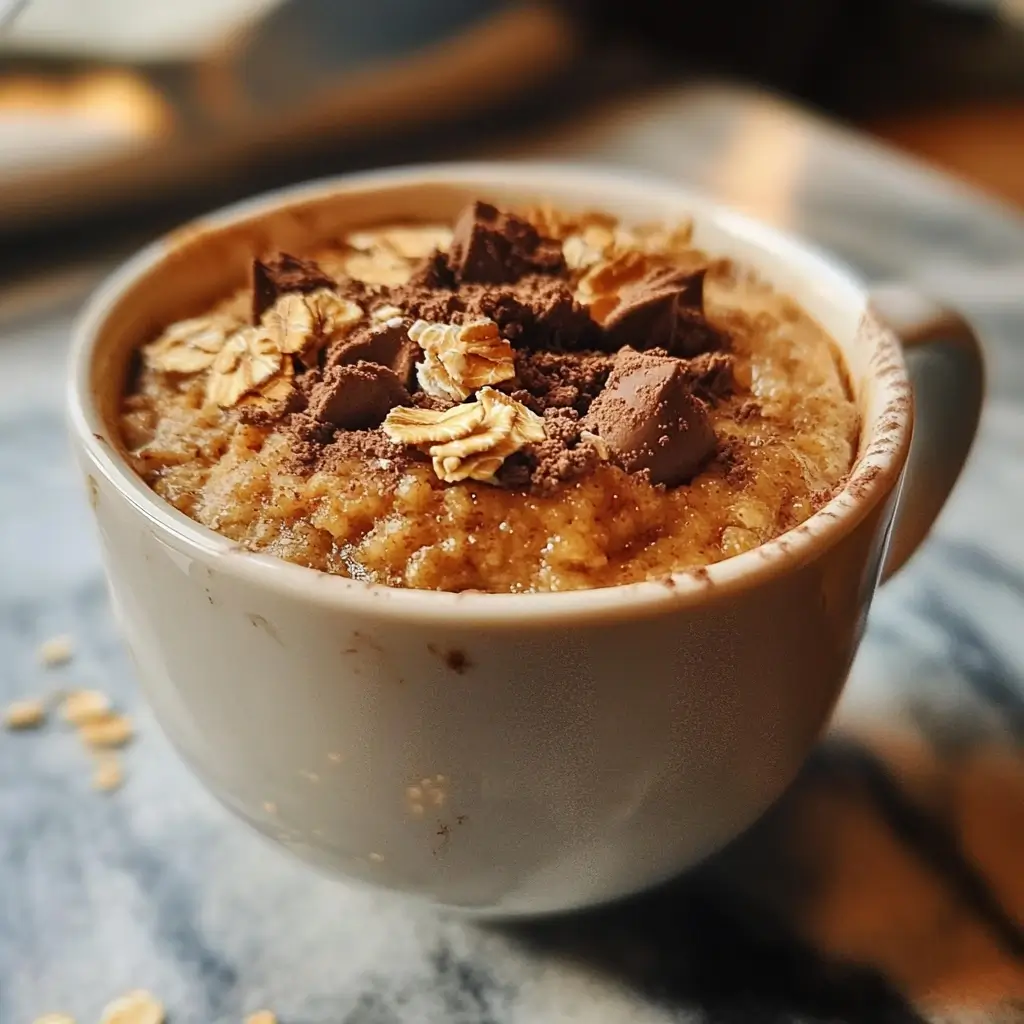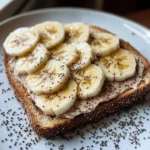Okay, let’s dive into the cozy world of quick and delicious treats! This Microwave Oat Mug Cake has become an absolute lifesaver in our household. Mornings can be chaotic, and evenings often leave me craving something sweet but not wanting a huge baking project. The first time I whipped this up, my kids were skeptical – “Cake in a mug? Cooked in the microwave?” But one bite in, and their eyes lit up! It’s warm, it’s comforting, and the fact that it’s made with wholesome oats makes me feel a little less guilty about indulging. It’s now a regular request, whether for a speedy breakfast before school or a satisfying after-dinner treat. The sheer simplicity combined with its delightful taste and texture truly makes it a winner. Plus, cleanup is a breeze – just one mug!
Ingredients
Here’s what you’ll need to create your very own delicious Microwave Oat Mug Cake:
- Rolled Oats (or Quick Oats): 1/2 cup (40g) – The star of the show, providing fiber and a lovely chewy texture. Quick oats will yield a slightly softer cake.
- Milk (any kind): 1/4 cup (60ml) – Dairy, almond, soy, oat milk all work wonderfully to add moisture.
- Egg: 1 small or medium – Binds the cake together and adds richness. (See tips for egg-free version).
- Maple Syrup (or Honey/Agave): 1-2 tablespoons (15-30ml) – For sweetness; adjust to your preference.
- Baking Powder: 1/2 teaspoon – The leavening agent that helps your mug cake rise and become fluffy.
- Vanilla Extract: 1/4 teaspoon – Adds a classic, warm flavor.
- Cinnamon (optional): 1/4 teaspoon – For a touch of warmth and spice.
- Pinch of Salt: Just a tiny bit to enhance all the other flavors.
- Optional Mix-ins: 1-2 tablespoons – Such as chocolate chips, berries, chopped nuts, or a spoonful of peanut butter.
Instructions
Creating this delightful Microwave Oat Mug Cake is incredibly simple and quick. Follow these steps for a perfect single-serving treat every time:
- Choose Your Mug: Select a microwave-safe mug that’s at least 10-12 ounces in capacity. This is important to prevent the batter from overflowing as it cooks and rises. A wider mug generally cooks more evenly.
- Combine Dry Ingredients: In your chosen mug, add the rolled oats, baking powder, cinnamon (if using), and salt. Stir these dry ingredients together with a fork to ensure they are well distributed. This helps the baking powder to work effectively for an even rise.
- Add Wet Ingredients: To the same mug, add the milk, egg, maple syrup (or your chosen sweetener), and vanilla extract.
- Mix Thoroughly: Using the fork, whisk all the ingredients together directly in the mug until just combined. Make sure to scrape the bottom and sides of the mug to incorporate any dry patches of oats or flour. Be careful not to overmix; just mix until everything is moistened.
- Stir in Mix-ins (Optional): If you’re using any optional mix-ins like chocolate chips, berries, or nuts, gently fold them into the batter now. You can also reserve a few to sprinkle on top before cooking.
- Microwave: Place the mug in the center of your microwave. Cook on high power. The cooking time will vary depending on your microwave’s wattage:
- For a 900-1000W microwave: Cook for 60-90 seconds.
- For a 700-800W microwave: Cook for 90-120 seconds (1.5 to 2 minutes).
Start by checking at the lower end of the time range. The cake is done when it has puffed up, the top looks set (it might still be slightly moist but not wet), and a toothpick inserted into the center comes out mostly clean or with a few moist crumbs.
- Rest and Cool: Carefully remove the mug from the microwave – it will be hot! Let the mug cake rest for 1-2 minutes. This allows the cake to finish cooking from the residual heat and cool down slightly, making it safer and more enjoyable to eat.
- Serve: Enjoy your delicious Microwave Oat Mug Cake straight from the mug! You can add your favorite toppings if desired (see “How to Serve” section for ideas).
Remember that microwave power varies, so you might need to adjust the cooking time slightly for your specific appliance. The first time you make it, keep a close eye on it to find the perfect cooking duration for your microwave.
Nutrition Facts
Understanding the nutritional profile of what you eat can be empowering. Here’s an approximate breakdown for one serving of the basic Microwave Oat Mug Cake (without optional mix-ins, using 1 tbsp maple syrup and dairy milk; values can vary based on specific ingredients used):
- Servings: 1 mug cake
- Calories per serving: Approximately 250-300 kcal. This makes it a satisfying yet relatively light option for breakfast or a snack.
- Fiber: Approximately 4-5g. Primarily from the oats, fiber is crucial for digestive health, helping to keep you full and maintain stable blood sugar levels.
- Protein: Approximately 10-12g. Oats, egg, and milk contribute to the protein content, which is important for muscle repair, satiety, and overall bodily functions.
- Carbohydrates: Approximately 35-40g. These are your body’s primary energy source, with a good portion coming from the complex carbohydrates in oats, providing sustained energy.
- Sugars: Approximately 10-15g (mostly from maple syrup). You can control this by adjusting the amount of sweetener used. Choosing natural sweeteners like maple syrup or honey offers some additional micronutrients compared to refined sugar.
Disclaimer: These are estimated values. Actual nutritional content will vary based on the precise ingredients, brands, and quantities used, especially with optional mix-ins.
Preparation Time
One of the most appealing aspects of this Microwave Oat Mug Cake is its incredible speed and efficiency.
- Preparation: Gathering ingredients and mixing them in the mug takes approximately 2-3 minutes.
- Cooking Time: The microwave cooking time is typically between 60 seconds to 2 minutes, depending on your microwave’s wattage.
- Total Time: From start to finish, you can have a warm, delicious oat mug cake ready in under 5 minutes!
This minimal time commitment makes it an ideal solution for busy mornings when you need a quick and nutritious breakfast, a fast afternoon pick-me-up, or a satisfying dessert when you don’t want to spend hours in the kitchen. It’s the ultimate convenience food without compromising on homemade taste and quality.
How to Serve
While this Microwave Oat Mug Cake is delightful on its own, straight from the mug, adding a few simple toppings or accompaniments can elevate it to a new level of deliciousness and customize it to your liking. Here are some ideas:
- Fresh Fruit:
- A handful of fresh berries (strawberries, blueberries, raspberries, blackberries) add a burst of freshness and antioxidants.
- Sliced banana provides natural sweetness and potassium.
- Chopped peaches or mango for a tropical twist.
- Creamy Toppings:
- A dollop of Greek yogurt or plain yogurt for extra protein and a tangy contrast.
- Coconut yogurt for a dairy-free creamy option.
- A swirl of whipped cream (or coconut whipped cream) for a more indulgent dessert.
- Sweet Drizzles:
- An extra drizzle of maple syrup or honey.
- A spoonful of your favorite nut butter (peanut butter, almond butter, cashew butter) melted slightly.
- A drizzle of melted chocolate or chocolate sauce.
- Fruit compote or a spoonful of jam.
- Crunchy Elements:
- A sprinkle of chopped nuts (walnuts, pecans, almonds, pistachios).
- A scattering of seeds (chia seeds, flax seeds, sunflower seeds, pumpkin seeds).
- Granola for added texture and crunch.
- Spices and Powders:
- An extra dash of cinnamon or nutmeg.
- A light dusting of powdered sugar.
- A sprinkle of cocoa powder for a hint of chocolate.
- For a Decadent Dessert:
- Serve warm with a small scoop of vanilla ice cream or your favorite non-dairy alternative. The contrast of warm cake and cold ice cream is divine!
Serving Occasions:
- Quick Breakfast: Top with yogurt and berries for a balanced start to your day.
- Healthy Snack: Enjoy plain or with a drizzle of honey to curb afternoon cravings.
- Easy Dessert: Add chocolate chips to the batter and top with whipped cream or ice cream for a satisfying sweet treat.
Experiment with different combinations to find your favorite way to enjoy this versatile Microwave Oat Mug Cake!
Additional Tips
To ensure your Microwave Oat Mug Cake turns out perfectly every time and to inspire some creative variations, here are eight additional tips:
- Mug Matters: The size and shape of your mug are crucial. Use a microwave-safe mug that holds at least 10-12 ounces (around 300-350ml). This prevents the batter from bubbling over as it cooks and rises. A mug with straighter sides tends to cook more evenly than one that is heavily tapered. If you only have smaller mugs, consider halving the recipe or being extra vigilant for overflows.
- Don’t Overmix the Batter: When combining the wet and dry ingredients, mix only until they are just incorporated. Overmixing can develop the gluten (even in oats, there are proteins that can act similarly when over-agitated), leading to a tougher, chewier cake rather than a tender one. A few small lumps are perfectly fine.
- Know Your Microwave’s Wattage: Microwave ovens vary significantly in power. A higher wattage microwave will cook the cake much faster. If you’re unsure, it’s always better to start with a shorter cooking time (e.g., 60 seconds) and add 15-20 second increments until it’s done. The cake is ready when the top is set and a toothpick inserted into the center comes out clean or with a few moist crumbs.
- Spice it Up or Flavor it Differently: Don’t limit yourself to just vanilla and cinnamon. Experiment with other extracts like almond extract or a tiny drop of peppermint extract (especially if using chocolate chips). Try different spices like nutmeg, cardamom, or pumpkin pie spice for a seasonal twist. A little citrus zest (lemon or orange) can also brighten the flavor.
- Make it Vegan Easily: For a vegan Microwave Oat Mug Cake, replace the egg with a “flax egg” (1 tablespoon ground flaxseed mixed with 3 tablespoons water, let sit for 5 minutes to thicken) or 1/4 cup of unsweetened applesauce or mashed banana (this will alter the flavor slightly). Ensure you use a plant-based milk like almond, soy, or oat milk.
- Go Gluten-Free Safely: Oats are naturally gluten-free, but they are often processed in facilities that also handle wheat, barley, and rye, leading to cross-contamination. If you have celiac disease or a gluten sensitivity, make sure to use certified gluten-free rolled oats to ensure your mug cake is safe to eat.
- Boost the Protein: If you’re looking to increase the protein content, especially for a post-workout snack or a more filling breakfast, consider adding a tablespoon of your favorite protein powder (vanilla or unflavored would work best) to the dry ingredients. You might need to add an extra tablespoon of milk to maintain the right batter consistency.
- Best Eaten Fresh, But Storage is Possible: This Microwave Oat Mug Cake is undeniably best enjoyed warm, straight from the microwave. However, if you happen to have leftovers (unlikely for a single serving!), you can cover the mug with plastic wrap and store it in the refrigerator for up to a day. Reheat it gently in the microwave for 15-20 seconds before eating, though the texture might not be quite as perfect as when freshly made.
By keeping these tips in mind, you can customize your oat mug cake to your dietary needs and taste preferences, ensuring a delicious and satisfying treat every single time.
FAQ Section
Here are answers to some frequently asked questions about making the Microwave Oat Mug Cake:
Q1: Can I use quick oats or steel-cut oats instead of rolled oats?
- A1: Yes, you can use quick oats. They will absorb liquid faster and may result in a slightly softer, less chewy texture than rolled oats, but the cake will still be delicious. If using quick oats, the cooking time might be slightly shorter. Steel-cut oats are not recommended for this recipe as they require a much longer cooking time and more liquid to become tender, which isn’t suitable for a quick microwave mug cake.
Q2: Can I make this oat mug cake without an egg?
- A2: Absolutely! The egg helps with binding and texture, but you can substitute it. Good vegan options include:
- Flax Egg: Mix 1 tablespoon of ground flaxseed with 3 tablespoons of water. Let it sit for 5-10 minutes to thicken before adding to the batter.
- Mashed Banana: Use 1/4 of a ripe mashed banana. This will add a banana flavor to your cake.
- Applesauce: Use 1/4 cup of unsweetened applesauce. This adds moisture and a subtle sweetness.
The texture might be slightly denser or moister with these substitutions, but still very enjoyable.
Q3: How do I know when my microwave oat mug cake is properly cooked?
- A3: The cake should have risen and the top should look set and feel springy to a light touch. It might still appear slightly moist on the very top, but it shouldn’t be wet or liquidy. The most reliable way to check is to insert a toothpick or a thin skewer into the center of the cake. If it comes out clean or with just a few moist crumbs attached, it’s done. If it comes out with wet batter, microwave for another 15-20 seconds and check again.
Q4: Can I double the recipe to make two mug cakes or one larger cake?
- A4: It’s generally best to make mug cakes individually. Doubling the recipe in one very large mug can lead to uneven cooking – the edges might overcook and become tough while the center remains undercooked. If you want two mug cakes, prepare the batter in two separate, appropriately sized mugs and cook them one at a time in the microwave for best results.
Q5: What is the best type and size of mug to use for this recipe?
- A5: The ideal mug is microwave-safe and has a capacity of at least 10-12 ounces (approximately 300-350ml). This provides enough room for the batter to rise without spilling over. Mugs with fairly straight sides tend to promote more even cooking compared to heavily tapered or very wide-brimmed mugs. Avoid using mugs with metallic trim or paint, as these are not microwave-safe.
Q6: My mug cake overflowed in the microwave! What went wrong?
- A6: This is a common issue and usually happens for one of two reasons (or a combination):
- Mug too small: The batter needs room to expand as it cooks and rises due to the baking powder. If the mug isn’t large enough (less than 10-12 oz capacity), it will likely overflow.
- Too much leavening: Ensure you’re using the correct amount of baking powder. Using too much can cause the cake to rise too quickly and aggressively, leading to an overflow.
Always place the mug on a microwave-safe plate to catch any potential spills just in case, especially the first time you make it or if using a new mug.
Q7: Can I prepare the dry ingredients in advance for even quicker assembly?
- A7: Yes, this is a great time-saving tip! You can pre-mix the dry ingredients (oats, baking powder, salt, cinnamon if using) and store them in individual small airtight containers or zip-top bags. When you’re ready for a mug cake, just empty a pre-mixed pack into your mug, add the wet ingredients, mix, and microwave. This makes the process even faster, perfect for ultra-busy mornings.
Q8: Is this microwave oat mug cake recipe considered healthy?
- A8: Generally, yes, this oat mug cake can be a healthy option, especially compared to traditional cakes or pastries. Oats are a whole grain rich in fiber, which aids digestion and promotes fullness. The recipe uses a modest amount of natural sweetener, and you can control the sugar content. Using an egg adds protein. However, “healthy” is subjective and depends on your overall diet and individual nutritional needs. Adding lots of chocolate chips, sugary toppings, or using excessive sweetener will make it less “healthy.” Portion control is also key. As a balanced breakfast or a mindful treat, it’s a good choice.






